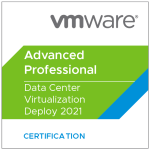Preparation for VCAP5-DCA (VDCA510) Exam
This page is intended to provide advice to IT Professionals, who plan to take the VDCA510 Exam and become VMware Certified Advanced Professionals on Datacenter Virtualization (VCAP5-DCA).
The basic steps to become a VCAP5-DCA is to first become a VCP5-DV, gain hands on experience and real knowledge on advanced vSphere 5 administration, and pass the VDCA510 Exam. I recommend that professionals, who already achieved VCP5-DV status and are looking for a quick means to earn VCAP5-DCA status, should consider attending the VMware vSphere: Optimize and Scale [v5.X] course. This class is a perfect follow-up course for those candidates, who took the vSphere Install Configure Manage class. It extends their knowledge to focus on optimizing and managing a growing environment. If the candidate took the vSphere FastTrack class, then the Optimize and Scale class will have some overlap in content, but it will still provide a more in-depth look at each topic and certainly provide lab exercises that are very helpful toward exam preparation. Each candidate should decide if they wish to take the course or simply study and practice on their own.
I recommend that you begin by reviewing the official VMware Certification webpage for VCAP5-DCA. Pay close attention to the Exam Blueprint, which provides an outline of each skill that you are expected to be able to perform hands-on. Use the link to VCAP-DCA Exam UI Demo to get familiar with the lab environment that will be used during the exam. The Exam is 100% hands-on. It contains many tasks, where each is fairly complex having multiple steps. The key is to practice performing tasks related to each element listed in the Blueprint and ensure that you can perform each task quickly. I recommend that you prepare a Test Lab containing a small vSphere implementation. I recommend that as you review each skill item in the Blueprint, think about how the skill may be applied to perform some actual configuration and administration task in the Test Lab. Make a list of corresponding, specific tasks that you can practice in the Test Lab. Consider this list to be your List of Practice Tasks.. Practice performing these tasks in the Test Lab until you become comfortable performing them rather quickly. You want to ensure that during the exam, you can quickly review, interpret, and perform each task.
Notice that many of the skills involve troubleshooting. As you practice the steps in your List of Practice Tasks, consider how to troubleshoot each item. Think of the related settings, components, and requirements. Predict the impact of any misconfigurations. Purposely misconfigure various elements and familiarize yourself with the resulting symptoms. Use this practice to develop your own troubleshooting methodology for each item. Be prepared to troubleshoot these items during the exam.
A Sample List of Practice Tasks:
Here is a sample list that I created by my interpretation of the Blueprint. The following list of tasks is Not identical to the list of tasks in the actual exam. This is Not a brain dump of the actual exam. This list of tasks does cover most of the items in the Exam Blueprint. I certainly recommend that you use this just as a starting point. You should actually review the Blueprint and produce your own list. For each item in this Sample List, refer to the Optimize and Scale course materials, the Supplemental Page on vLoreBlog, or some other reference to determine how to perform the task.
- When performing many of the following tasks, try to determine the proper “esxcli” namespace to use. It may be difficult to memorize the entire name space, so practice “figuring out” which namespace, command and parameters are needed. With practice, this namespace approach can be utilized to determine the right command quickly. For example, try to determine how to use esxcli to list all the NICs in an ESXi host. To get started, just enter esxcli and review the top-level namespace items that are available. Then enter esxcli network to see what namespace items are available at that level . Continue forward to determine the full command for listing all the NICs in an ESXi host.
- Virtual Disk Types – attach four virtual disks to one VM, where one disk is thin provisioned, one is thick eager zeroed, one is thick lazy zeroed, and one is a Raw Device Mapping
- Temporarily change a vSphere Storage Filter such that LUNs that already contain a VMFS datastore are shown whenever the Add Storage wizard is used to create a new VMFS datastore. (Be sure to change the filter back to original setting after testing!)
- Use commands from the vMA to set the path selection policy for a SCSI device to Round Robin, change the claim rule for another device to MASK_PATH, and tag another device as “SSD”
- Use the vscsistats command to produce histograms showing latency, arrival rate, IO size, and seek times for a specific virtual disk.
- Disable ATS locking and hardware assisted move / copy on an ESXI server.
- Storage Profiles and Storage DRS:
- Configure user capabilities named “SAS” and “SATA” Assign the SAS capability to two VMFS datastores and assign SATA to two others.
- Create storage profiles named “Tier-1” and “Tier-2”. Map Tier-1 to the SAS capability and Tier-2 to the SATA capability.
- Assign three VMs to Tier-1 and three VMs to Tier-2. Check for Compliance. If necessary, migrate VMs to make them compatible with their storage profile.
- Create a new user capability named “SSD” and assign it to one new VMFS datastore. Change the Tier-1 storage profile to map to the SSD capability. Check the Tier-1 VMs for compliance and migrate VMs if necessary
- Create a Storage DRS cluster. Set space utilization threshold to 90%, latency threshold to 30 ms, and time interval to check for IO imbalances to 3 hours.
- Place a datastore into maintenance mode.
- Create a datastore alarm to trigger when overcommitment = 150%
- Configure iSCSI software adapter to bind to two vmkernel ports, each mapped to their own NIC, and successfully access iSCSI devices. (If needed, implement a VM based iSCSI appliance for practice, perhaps Open Filer or a Windows VM with MS iSCSI Target)
- Enable the SNMP agent on an ESXI host and set its SNMP trap destination (assuming an SNMP receiver is available in the network). Send a test trap from the host.
- Distributed Virtual Switch:
- Create and configure a new distributed vSwitch. Using a single wizard, migrate all objects (vNICs, vmkernel ports, and VMs) form a specific standard vSwitch to the dvSwitch.
- Add several port groups to the dvSwitch, each with 10 ports, some with dynamic binding and some with static binding. Add one port group with ephemeral binding.
- Attach VMs to each port group. Identify which ports were used to connect each VM.
- On the dvSwitch, set MTU = 9000. Configure LLDP in Listen Mode.
- Create three private VLANs, one Isolated, one Community, and one Promiscuous. Attach at least two VMs to each port group and utilize the ping command in the VMs to validate that each PVLAN works correctly. (Hint: Instead of configuring PVLANs on a physical switch, this task could be done using dvSwitch port groups that have No active or standby uplinks, and only one attached ESXi host. In this case, only utilize VMs on the attached ESXi host.)
- Configure port mirroring on a dvSwitch to mirror all traffic from one port to another. Attach VMs to the ports and use Network Monitor or TCP Dump in the VM on the destination port to verify successful mirroring.
- Create a port group on a dvSwitch, change its security settings to maximum hardness and change its behavior to use Load Based teaming,
- Use the net-dvs command to determine the names of the port groups on a dvSwitch.
- Enable network I/O control, change shares on VMotion network resource pool to Low, and create a user defined resource pool for “Test VMs” and attach at least two port groups to it.
- Create a standard vSwitch from command line, attach two NICs, create a VM port group, set the port group’s VLAN. Use the command line to create a vmkernel port on a standard vSwitch.
- DRS / DPM / EVC:
- Create a DRS cluster with just two hosts, configure full automation, configure EVC, create a rule to separate two specific VMs. With all VMs running, without any VM disruption, and without deleting the rule, take one ESXi host to maintenance mode.
- Configure DPM for full automation and configure it so that it cannot shut down at least one specific ESXi host in the cluster.
- Configure EVC in a cluster and set it for the highest appropriate level based on the actual CPUs
- vSphere High Availability and Fault Tolerence:
- Configure vSphere High Availability. Enable Admission Control to allow 1 concurrent host failure. Set the maximum HA slot size to 1 GB.
- Configure HA to utilize two vmkernel ports for heartbeats, on two different networks, and ensure that the isolation test attempts to ping the gateways on both networks . Change which VMFS datastores are used for the VMFS heartbeat.
- Configure HA for VM (VMare Tools) heartbeat monitoring to trigger after 45 seconds of heartbeat loss.
- Prepare a VM for Fault Tolerance (verify that FT requirements are met). Ensure the VM meets all VMotion requirement and it is configured for HV only not HWMMU. Ensure vMotion is configured. Ensure the vRAM for the secondary can be fully reserved (sufficient unreserved resources exist on another ESXi host). Ensure the virtual disk is thick eager zeroed. Ensure a vmkernel port is configured for FT Logging.
- Configure Fault Tolerance to protect a specific VM with FT. Identify the host that runs the secondary. Test failover. Migrate the secondary VM. Migrate the primary VM
- Performance Graphs and ESXTOP:
- Change the Performance Graphs statistics level such that it includes “CPU Ready Time” in the past Day, Week, and Month views.
- Create a performance graph for a cluster showing Memory Overhead and Memory Active for past Day.
- Create a performance graph for an ESXi host, showing Disk Usage and Highest Latency for past week
- Create a stacked VM graph for a specific host showing CPU usage for Custom time range. Save a performance graph data as an Excel spreadsheet
- Change the CPU and RAM reservations on a VM to the maximum values. Change the processor affinity of the VM to force it to run on specific physical cores. Change the VM so that it cannot utilize Intel-EPT, but can utilize Intel VT-x. Change the VM’s swap file location.
- Configure resxtop to display only ballooning related memory fields for just VM worlds (not driver worlds or other worlds). Save the configuration to become the default settings for resxtop.
- Run resxtop in a batch mode, where its sampling period is five minutes and its data is save to a CSV file.
- Use Update Manager to download patches, create a base line of Critical Patches that are at least 30 days old, and remediate any ESXi hosts that are not in compliance
- Install vSphere Log Collector. Configure ESXi hosts to send logs to the collector and configure the collector to maintain a unique folder for each ESXi host. Verify proper firewall ports are open. Configure syslog collection for specific rotation, size of logs, etc.
- User Accounts and Hardening:
- Enable ESXi Shell and SSH, but only allow SSH access from a a specific IP subnet. Disable the DCUI.
- Configure SSL Timeouts on a ESXi host. Change the default certificates with signed certificates (or at least memorize the steps to do so).
- Enable ESXi lockdown mode.
- Modify the ESXi hosts to allow Domain Admins to log on directly to the ESXi host using the vSphere Client using their AD accounts.
- Deploy and configure a vCenter Appliance. Create a local user account on the vCenter appliance and set permissions to assign the Administrator Role to the account for all objects in vCenter. Add the appliance to Active Directory and configure it to allow Domain Admins to login and have administrator role to all objects.
- Manage Datastores:
- Use vmkfstools to view details on a VMFS volume. Use vmkfstools to create a new virtual disk
- Perform the following sequence of tasks twice, once from GUI and once from command line. Unmount a VMFS datastore, rescan the SAN, re-Attach the datastore and rescan.
- Format LUNs with VMFS, expand VMFS to use all the available space in a LUN, span a VMFS datastore across two LUNs.
- Configure a VM to only repeat pressed keys, only if the keys are pressed and held for at least two seconds.
- Configure a vApp, add 3 VMs to the vApp, configure a specific start-up order. Export the vApp to OVF.
- Use Storage View tab to create three separate reports: One to view all files for a VM, one to view all SCSI volumes in the datacenter, and one to view all NAS volumes attached to a specific ESXi host.
- Create a host profile from a host and make these settings in a host profile: Change firewall to allow SSH Client, change the default PSP for one of the SCSI devices, change number of ports on a vSwitch to 256, and disable DCUI. Attach the profile to one or more hosts, check for compliance, and remediate. Export the profile, import the profile and clone the profile.
- Create a PowerCLI script to show snapshots for all VMs, including snapshot name, snapshot date, snapshot size. Create another script to show all VMs with a connected virtual CD. Create another to show all vNIC connections, including port-group connection of each. (For details on getting started with PowerCLI, look at the PowerCLI section of the Optimize and Scale Supplemental page on vLoreBlog. It provides details for installation as well as sample PowerCLI scripts)
- Use vmware-cmd to start a VM. Use it again to gracefully shutdown the VM
- Use the Image Builder commands to create new ESXi images and export an image to an ISO file.
- Configure AutoDeploy and use it to allow an ESXi host to successfully do network boots for a specific ESXi image, connect to vCenter, and apply a host profile. (Hint: in a test network, a vCenter appliance can be configured to run Auto Deploy, DHCP Service, TFTP service, etc. For details, see the Documentation Center)






Thanks for the insights on tasks that covers objectives on the exam blueprint.
It seems to me quite a few of the tasks are covered by labs in the instructor led course VMware vSphere Fast Track – I am sure many more a covered in the Optimize & Scale course.
Is there anything more available like this? I’m also preparing for VCAP-DCA and whilst working through the blueprint, I find it difficult to get an understanding of what one can expect on the exam. Questions like these help by showing a global idea.
You may find this useful: http://my.safaribooksonline.com/9780133579727?cid=shareLink
Hey John, i’ve been studying for the VCAP5-DCA and getting ready to take a class, just wondering if you’re teaching any of the upcoming Optimize and Scale 5.5 classes?
Tomorrow, I am wrapping up an Optimize and Scale 5.5 course in Chicago. I cover another such course in DC beginning June 2nd.
If you happen to get a choice, and want to come back to DC, I’d love to take another course under you. I just signed up for the VMware vSphere: Optimize and Scale [V5.5] class in DC on Jul 21 – 25, 2014.
Wow. Sample tasks you provided are really useful. I will test them during my VCAP5-DCA journey.
Cool. You may want to take a look at the new Official VCAP5-DCA Cert Guide. It has a lot more detail including information on the new VDCA550 exam and you may recognize the authors.
Just got the book in yesterday. From a brief skim, i’m liking chapter 10.
What??? No way, I’m gonna pick this up today…thanks for the info